Air pollution in Taiwan
Air pollution in Taiwan is mostly derived from sources of domestic combustion, primarily the burning of fossil fuels. [1] Taiwan's topography has been noted to be a contributing factor to its air pollution problem, leading to poor dispersal and trapping pollutants. Taipei, Taiwan's capital and largest city for example, is surrounded by mountains, and other industrial centers along the northern and western coasts of Taiwan are surrounded by high mountains.[2]
Types of pollutants
PM10
In March 2014, Taiwanese legislators and the Taiwan Healthy Air Action Alliance claimed, based on reports by the World Health Organization, that the air quality in Taiwan is generally the worst of all of the Four Asian Tigers, in particularly drawing attention to the annual mean PM10 level of Taiwan (54 micrograms per cubic meter). The annual mean PM10 level of the country's capital Taipei (47.1 micrograms per cubic meter) made the city rank only 1,089 among 1,600 included cities around the world.[3] Based on 2004 data by Taiwan's Department of Environmental Protection, the annual mean PM10 level for Taiwan had, for the last decade, been worse than the European Union limit value (40 micrograms per cubic meter) every year.[4]
Fugitive dust
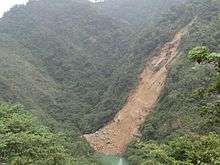
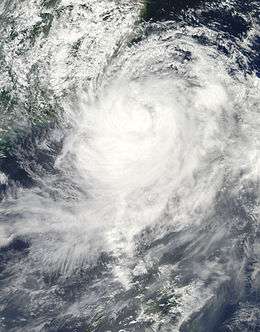
During examinations of the 2013—2014 winter by the Environmental Protection Administration's (EPA) Department of Environmental Monitoring and Information Management, it was reported that stations in Yunlin, Chiayi and Greater Tainan often had the worst pollution concentrations. According to the EPA Department's Deputy Director Chang Shuenn-chin (張順欽) this is caused by fugitive dust at riverbanks during the low-flow season of winter. These particles — suspended in the air by wind action and human activities — can be stirred up by the strong northeastern winds occurring in winter, also known as the northeastern monsoon. As such, wind speeds exceeding three meters per second are likely to cause gusts of fugitive dust with PM10 concentration levels above 250μg/m3. High maximum readings in PM10 concentration levels in Yunlin County's Lunbei Township (崙背) in 2015 (2,532μg/m3) and in Chiayi County's Puzih City (朴子) in 2009 (1,793μg/m3) and; in 2013; in Puzih (497μg/m3) and in Lunbei (497μg/m3) are claimed to be heavily influenced by heavy rainfall and mudslides during Typhoon Morakot in 2009 as well as by the 6.2 Mw June 2013 Nantou earthquake. Earthquakes may shake up loose soil on upstream slope areas, later washed downstream by torrential rains during the summer. This increases the likelihood for land collapse and mud slides, which in turn creates dust on riverbanks.[5]
PM2.5
With regards to research conducted on PM2.5 particles in Taiwan, the National Taiwan University in March 2015 claimed that traffic is the major source of air pollutants in Taipei, while fine particles are produced primarily by thermal power plants in Central Taiwan.
While presenting this research, the National Taiwan University communicated that the annual mean concentration of PM2.5 particles in Taipei City and New Taipei City is 20 µg/m3, while being 30 µg/m3 in Kaohsiung. Further more, in greater Taipei, the outdoor PM2.5 concentration in the air at ground-level up until the height of three-stories is around ten to twenty times higher than the concentration in the air at the height of four-story buildings and above. Levels of other hazardous suspended particles such as silicon and iron were equally found to be significantly lower when increasing altitude. Professor Chang-Fu Wu (吳章甫) of the same university attributed this to dust and traffic pollution.
The normative limit value of PM2.5 in Taiwan is set at 15 µg/m3, which is no longer the same standard as that of the United States, having revised its standard to 12 µg/m3 in 2013.[6] The WHO suggested maximum exposure limit is lower still at 10 µg/m3.[7]
By November 2015, it was claimed that the EPA's PM2.5 Index indicated poor air qualities for almost one-third of Taiwan's cities for more than one hundred days that year, with Nantou topping the list at 147 such days. On November 8, central Taiwan, along with the Yunlin and Chiayi regions, reached the hazardous purple alert.[8]

Based on data from 2016, the Environmental group Air Clean Taiwan claimed in 2017 that Kaohsiung's Zuoying District, Yunlin's Lunbei Township and Pingtung were amongst the worst affected city (districts) in the country, with Lunbei topping the list regarding high levels of PM2.5, often prompting the red and purple alerts issued by the EPA.[9]
NO2
Based on 2004 data by Taiwan's Department of Environmental Protection, for the last decade, the average annual mean concentration of NO2 in Taiwan had equally surpassed the European Union limit value (40 micrograms per cubic meter) every consecutive year.[4]
Sources of pollution
Cross-border pollution from China
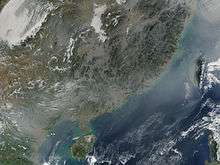
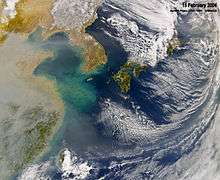
In February 2014, the Environmental Protection Administration's (EPA) Department of Environmental Monitoring and Information Management Director Chu Yu-chi (朱雨其) claimed there had been seven haze and dust storms since December 2013. Mr. Chu also reported that, for the largest part based on recent weather phenomena and air pollutant monitoring data from China's major cities, China's air pollution generally deteriorates the air quality in Taiwan significantly every winter. The EPA concluded that air pollutants brought in from China by strong winds was directly responsible for drastically rising the detected concentration levels of particles under 2.5 micrometers in diameter (PM2.5) at close to all of Taiwan's seventy-six monitoring stations. During the periods of cross-border haze, referring to pollution blown over from China, the pollution standards index (PSI) readings — which are based on the highest concentration value of five major air pollutants PM10 (particulate matter 10 micrometers or less in diameter), sulfur dioxide, nitrogen dioxide, carbon monoxide and ground-level ozone — at most stations reached unhealthy levels, while some stations in central and southern Taiwan even reached hazardous levels.
During those winter months, short-term health hazards due to the northeastern winds included mild symptoms of eye irritation, sneezing or coughing.[5] Epidemiological statistics also show that the short-term increase of air pollutant levels during the winter coincide with sudden spikes in hospitalization for cerebrovascular disease.[7]
With regards to spikes in PM10 particles concentration during periods of strong winds in the winter, fugitive dust and phenomena such as earthquakes, typhoons and other domestic geographical or meteorological factors must be taken into account.
Domestically produced pollution
Industry
seemingly featuring polluted air surrounding it.
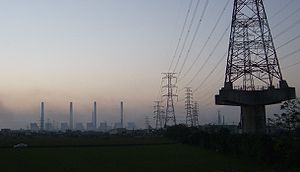 13 October 2007.
13 October 2007.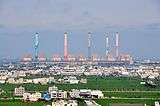 16 April 2010.
16 April 2010.
.jpg)
During warnings by the scientific community about increasing prevalence of lung cancer in Taiwan in December 2015, it was claimed that Taichung Power Plant, along with the Sixth Naphtha Cracking Plant of the Formosa Plastics Group account for roughly seventy percent of the air pollution in the Central Taiwan region of the country, emitting large quantities of sulfur oxides.[10]
Scooters
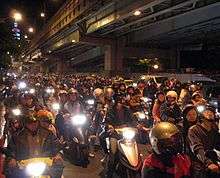
In a 1996 article, it was claimed that there were 8.8 million motorcycles and 4.8 million cars on Taiwan's roads, with motorcycles being called the primary means of transport for the majority of the island's adult population. Motorcycles with two-stroke engines were claimed to be the biggest single source of vehicular pollution in Taiwan, while also being the majority of the motorcycles operating in Taiwan.
You Yii-der of the Environmental Protection Foundation and Jay Fang of the Green Consumer Foundation were noted to propagate that all motorcycles powered by two-stroke engines should be banned.[11]
Religious rituals
In 2014 a study by Academia Sinica's Research Center for Environmental Changes claimed that, due to the burning of ghost money (also known as Joss paper) and incense during religious ceremony days (occurring mostly on the first and 15th days of the lunar calendar month), values of PM10 particles at large temples are at five to sixteen times the normal value of a regular household's environment. Equally, due to the burning of ghost money and incense, the households of communities with a nearby temple show an increase in PM2.5 particles value at an average of 15.1 micrograms per cubic meter.[12]
Monitoring
Taiwan Air Quality Monitoring Network (TAQMN)
When the domestic Environmental Protection Administration's (EPA) Taiwan Air Quality Monitoring Network (TAQMN) was established in 1990, it entailed nineteen air quality monitoring stations, having increased to sixty-six in 1993 and to seventy-two in 1998. In 2003, the pollutants which it monitored included NO2, CO, PM, O3, SO2 and HCs.[4]
In November 2015, the Conservation Mothers Foundation criticized the EPA, arguing that it was urging people to stay at home during periods of bad air quality, when they should rather be "inspecting and fining the major parties responsible for air pollution".[8]
See also (some only available in Chinese language originally)
- Air Pollution Prevention and Control Law (Year 1911+64)
- Air Pollution Prevention and Control Law (Year 1911+71)
- Air Pollution Prevention and Control Law (Year 1911+81)
- Air Pollution Prevention and Control Law (Year 1911+88)
- Air Pollution Prevention and Control Law (Year 1911+91)
- Air Pollution Prevention and Control Law (Year 1911+94)
- Air Pollution Prevention and Control Law (Year 1911+95)
- Air Pollution Prevention and Control Law (Year 1911+100)
- Air Pollution Prevention and Control Law (Year 1911+101)
- Air Pollution Prevention and Control Law (Year 1911+107)
References
- https://international.thenewslens.com/article/90010
- Giese-Bogdan, Stephanie; P. Levine, Steve (Fall 1995). "From Michigan to Taiwan: Air Pollution Technology". Journal of the International Institute. 3 (1).
- Lee, I-chia (13 March 2014). "Air quality worst among 'Tigers'". Taipei Times.
- Schwela, Dieter; Haq, Gary; Huizenga, Cornie; Han, Wha-Jin; Fabian, Herbert; Ajero, May (2006). Urban Air Pollution in Asian Cities: Status, Challenges and Management. Stockholm Environment Institute and the Clean Air Initiative for Asian Cities. London: Earthscan. ISBN 978-1-84407-375-7.
- Lee, I-chia (5 February 2014). "FEATURE: Air pollution reason for concern: groups". Taipei Times.
- "What are the Air Quality Standards for PM". United States EPA official website. 30 March 2013.
- "NTU Scholars Highlight Health Hazards Caused by PM2.5 Air Pollutants". National Taiwan University. 30 March 2015.
- "Taiwan's Current Serious Air Pollution Has Nothing To Do With China". The News Lens International Edition. 9 November 2015.
- Lee, Wendy (13 January 2017). "Kaohsiung's Zuoying, Yunlin's Lunbei the most polluted areas in Taiwan". Taiwan News.
- Olivia Yang, ed. (7 December 2015). "Lung Cancer Cases Increasing in Taiwan and Medical Community Calls On People to Demonstrate against Air Pollution". Translated by June. The News Lens International Edition.
- "Airborne Menace". Taiwan Today. 1 September 1996.
- Tang, Chia-ling; Pan, Jason (10 August 2014). "Ritual burning threatens health". Taipei Times.
External links
| Wikimedia Commons has media related to Air pollution in Taiwan. |